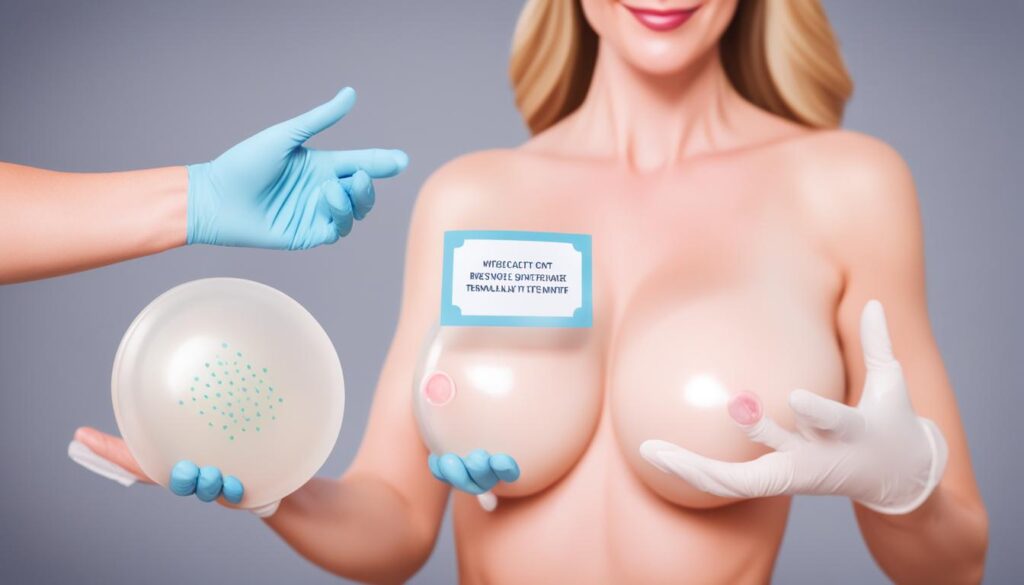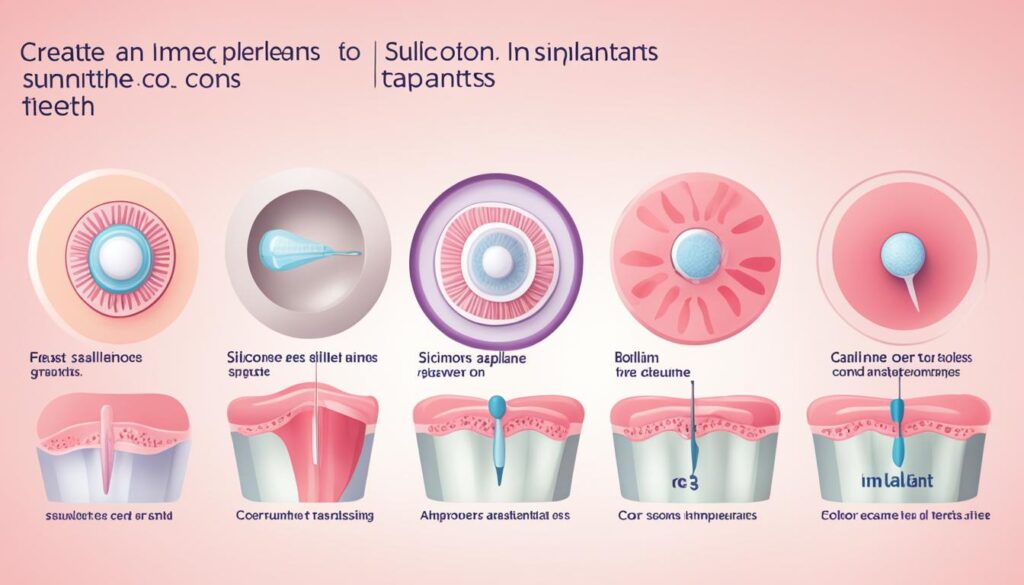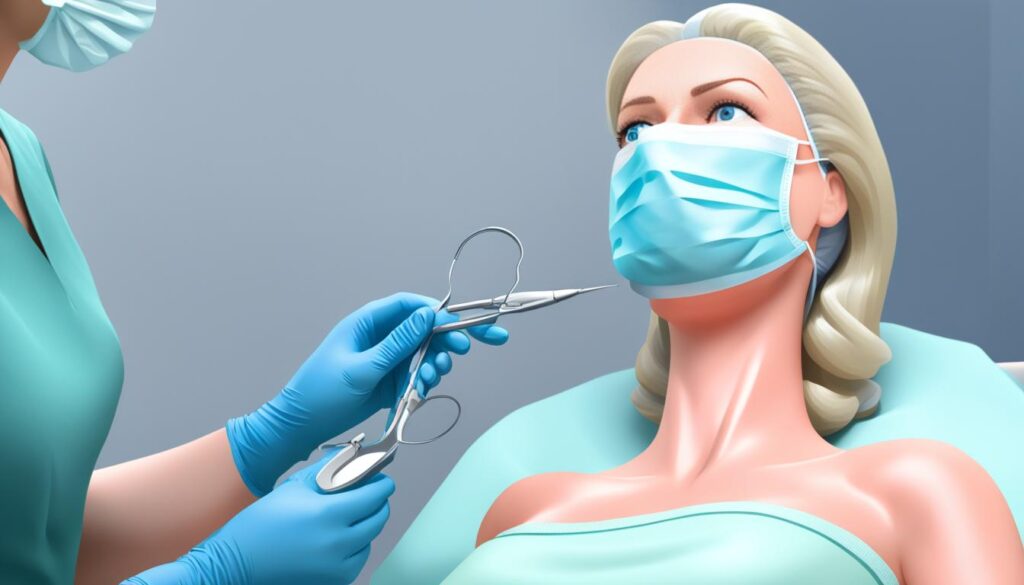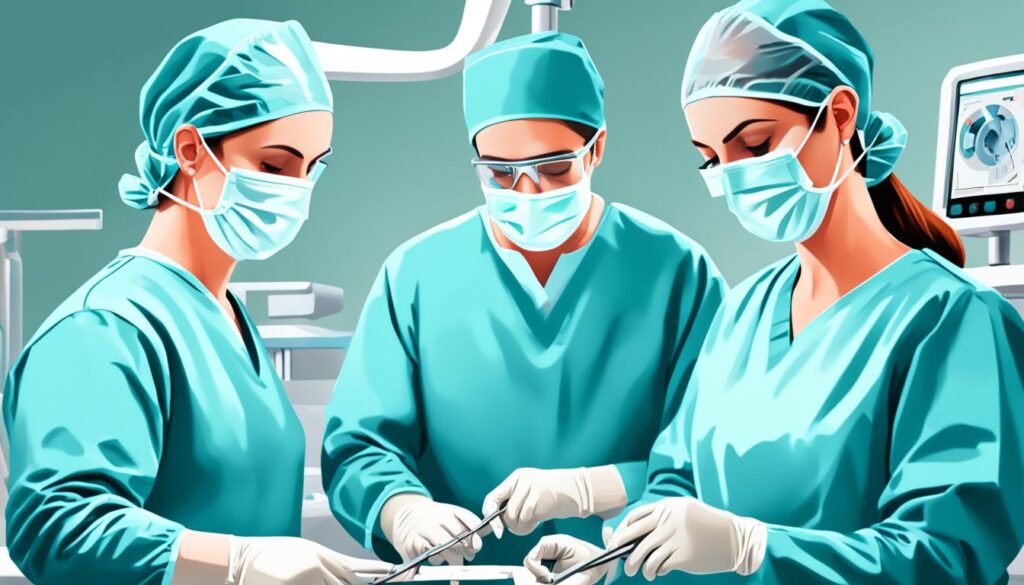An exchange surgery swaps out old breast implants for new ones. It helps people deal with problems or meet their beauty goals. This procedure also allows updating old implants to boost self-esteem. Let’s dive into why people choose exchange surgery and its benefits for them.
Key Takeaways:
- An exchange surgery entails replacing old breast implants with new ones.
- Complications, aesthetic preferences, or the desire to update aging implants may prompt individuals to undergo this procedure.
- Exchange surgery can have a profound impact on patient care by addressing concerns and improving self-confidence.
- Understanding the reasons for exchange, implant options, risks, and recovery guidelines is crucial for a successful surgical journey.
- Consulting with a skilled plastic surgeon is essential in making informed decisions and achieving desired results.
What is an Implant Exchange?
An implant exchange surgery replaces old breast implants with new ones. It might be suggested for complications, looks, or old implants. The surgery needs careful planning, a thorough check-up, the operation itself, and close care after.
During the consultation, a specialist will look at your needs and goals. They talk about options with you to help you decide wisely about the exchange. This step makes sure the surgery goes as you hope and has the results you want.
The pre-op check includes a detailed exam and going over your medical history. This helps the surgeon know if you’re right for the surgery. They might also ask for more tests, like scans or bloodwork, to learn more.
If you’re good to go, they’ll schedule your surgery. You’ll be under general anesthesia on the day to be comfortable and safe during the procedure.
There are many steps in the surgery. First, they take out the old implants and deal with any issues. Then, they put in new implants, considering what you want in size, shape, and look.
After, there’s important care to help you heal well. Your surgeon tells you how to care for your cuts, manage pain, and what activities to avoid. Following these steps closely helps lower risks and gets the best results.
You’ll have regular checks to see how you’re doing after the surgery. During recovery, your surgeon will be there to help and guide you.
Choosing an implant exchange lets you change your implants, fix problems, and update your look as you wish. This personalized surgery needs good planning, skilled surgery, and careful follow-up for great outcomes.
The Implant Exchange Process:
- Consultation with a specialist to discuss goals and options.
- Pre-operative evaluation to assess suitability for surgery.
- Surgery under general anesthesia to remove old implants and insert new ones.
- Post-operative care and follow-up appointments to monitor progress.
Reasons for Exchange
People may choose to get a breast implant exchange for different reasons. Complications like implant rupture, leakage, or capsular contracture can occur. These issues need surgery to fix, helping to achieve the look one wants and guaranteeing their well-being.
Also, personal tastes can change over time. Someone might want a different size or shape of implants as they get older. This change allows them to match how they look with their new aesthetic goals.
Old implants might need to be replaced to keep working well and last longer. As implants age, they can wear out. Swapping them with newer, more durable models is often needed.
There are many reasons for exchanging breast implants. It could be due to complications, a change in taste, or just old implants. Always think carefully and talk with a skilled plastic surgeon before deciding.
Reasons for Breast Implant Exchange
| Reasons | Description |
|---|---|
| Complications | Implant rupture, leakage, or capsular contracture |
| Changing Preferences | Desire for different size or shape of implants |
| Aging Implants | Need to replace older implants with newer models |
Understanding why you might want a breast implant exchange helps you make wise choices. It sets you on a path that meets your own goals and dreams.

Understanding Implant Options
When thinking about breast implant exchange surgery, there are different types to consider. Each type has unique features that fit various needs and likes.
Saline Implants
Saline implants have a sterile saltwater solution inside. One great thing about them is that their size can be changed during surgery. This means you can get just the right size. They look and feel natural and are safe even if they break.
Silicone Implants
Silicone implants are liked for their real look and feel. They’re made to act like natural breast tissue. You can pick from many shapes and sizes to get what you want. Modern improvements have made these implants safer than ever.
Gummy Bear Implants
Gummy bear implants keep their shape, even if they’re damaged. They’re firm and durable, made from a sticky gel. You can choose from shapes like teardrop or round for a custom look. They give a natural contour and are soft yet strong.
Choosing the right implant type is important. Safety first, all these options—saline, silicone, and gummy bear— are tested for safety. They each have benefits like looking natural, being adjustable, and lasting long. Your surgeon will help you pick based on what you need and want.

Risks and Complications
Like any surgery, implant exchange has certain risks. It’s key for patients to know these risks. Doctors work hard to lower them. Risks include:
Infection
Infection can happen after this surgery. Doctors use clean tools and methods to keep this risk low. They also tell patients how to care for their wounds and may prescribe antibiotics.
Bleeding
Bleeding is rare but can happen. To lower this risk, doctors are careful with the surgery. They tell patients to avoid certain medications before surgery. If bleeding is too much, another surgery might be needed.
Anesthesia-related Risks
This surgery needs anesthesia, which has risks. But, a skilled anesthesiologist watches the patient all through the surgery. They’re ready to handle any issues.
Changes in Nipple Sensation
Some might feel different in their nipple after surgery. It can feel less or more than before. This is usually temporary. Doctors talk about this before the surgery.
Scarring
Scarring is normal in any surgery. Surgeons try to cut where scars won’t show much. Good care after surgery can make scars less noticeable over time.
Doctors want to keep surgery risks as low as possible. Good care after surgery helps a lot. It’s important for patients to talk with their doctor about any worries. This helps patients know what to expect and how to get ready for recovery.

| Risks | Complications |
|---|---|
| Infection | Bleeding |
| Anesthesia-related risks | Changes in nipple sensation |
| Scarring |
Managing Expectations
Getting implant exchange surgery can be exciting as you aim for your goal. But, it’s vital to keep your expectations real. Healing and how your body reacts are different for everyone. This can depend on your skin, what your breasts are like currently, and the surgery method.
Talking with your surgeon is critical during your meeting. It’s key to talk openly about what you hope for, your worries, and what you want to see happen. Your surgeon will look at your situation closely. They will explain what changes you might see after the implant exchange surgery.
While the surgery can make a big difference, there are things it can’t do. Everyone’s body reacts in its own way to surgery. The results might not be exactly what you pictured. Your surgeon will help you keep your expectations in check. They will make sure you understand what’s likely to happen.
Being patient as you heal and listening to your surgeon after surgery is crucial. Knowing what changes to expect and what the surgery can’t do will help. You’ll feel more confident during recovery, understanding that healing takes time.
Communicating with your Surgeon
Your surgeon will guide you from the first talk to the end of healing. It’s important to keep talking to your surgeon. This helps manage your expectations and deal with worries you might have.
If you’re unsure about anything, call your surgeon. They have the know-how to guide you and give you peace of mind during your surgery. Being clear and talking things through means you and your surgeon will know what to expect. This makes for a better surgical experience.
Getting to your desired look is something you and your surgeon do together. By setting realistic goals and knowing what the recovery involves, you’ll be ready for the exciting changes. The surgery is a team effort for a great new look.

Expected Changes and Limitations
| Expected Changes | Limitations |
|---|---|
|
|
Knowing what to expect and the possible limits sets you up for the journey. Everyone’s experience and results will be their own. By trusting your surgeon and following their advice, you’re on your way to a successful surgery and happy changes.
Breast Implant Exchange Procedure
The breast implant exchange procedure involves swapping old implants for new ones. It’s often done under general anesthesia to keep you comfortable. This ensures the surgery goes smoothly.
Removal of Old Implants
The surgeon first takes out the old implants from your breast. This step is crucial for a clean start. It also helps fix any issues with the old implants.
Addressing Concerns
Before putting in new implants, your surgeon will talk about any concerns. They will discuss size, shape, and look you want. This helps achieve the best look for you.
Insertion of New Implants
After old implants are out and concerns discussed, in go the new implants. The surgeon will place them carefully. They consider what look you want and your body’s shape.

Post-Operative Guidelines
After surgery, you’ll get detailed care instructions. These will cover how to care for cuts, manage pain, and what activities to avoid. Following these helps you heal correctly.
It’s key to follow these guidelines for a good recovery. Doing so helps you get the best results.
Getting a breast implant exchange can fix concerns, update your look, and make you feel better about yourself. It’s a great way to boost confidence and be happy with your appearance.
Timing and Ease of Exchange
The right time for a breast implant exchange differs for each person. It is vital to talk with a trusted surgeon to find out the best time for your exchange. They will look at your current implants, any issues, and what you hope to achieve.
Many people have a breast implant exchange with other surgeries for better results. You can have breast enlargement, reduction, or a lift with the exchange. This saves time and cuts down on recovery time.
Whether you want bigger breasts, smaller ones, or to lift sagging breasts, your surgeon can help. They will guide you to meet your goals.
The Ideal Time for a Breast Implant Exchange
Every situation is different, but there are some common times to consider an exchange:
- If your implants have problems like breaking or hardening, see a surgeon right away.
- If you want new implants or a different size or shape, pick a time that fits your life and recovery needs.
- If you’re thinking about other breast surgeries, it’s best to do them all at once. This way, you get the best results with one surgery.
Talking to a skilled surgeon is the best way to figure out when to have a breast implant exchange. They will make sure you get what you want safely and effectively.
Your surgeon will guide you through the process. They’ll talk about risks and benefits, help pick the right implants, and explain how the exchange works.
Below is a table that goes deeper into the consultation process:
| Consultation Process | Description |
|---|---|
| Discussing goals and concerns | In the first meeting, you’ll talk about what you want and any worries. This helps the surgeon make a plan just for you. |
| Evaluation of current implants | The surgeon will check your implants for any issues that need fixing during the exchange. |
| Choosing the right implant size and type | The surgeon will help you pick the best size and type of implant based on your goals and body. |
| Surgical techniques and recovery | You’ll learn how the surgery is done and what to expect while you get better, including care after surgery and follow-up visits. |
With a good surgeon and by carefully thinking about your needs, a breast implant exchange can be a big change. By picking the right time and maybe adding other procedures, you can get the look you want and feel more confident.

Safety and Insurance Considerations
Safety is crucial for breast implant exchange surgery. Board-certified plastic surgeons stick to strict safety rules. This keeps patients safe and happy.
Insurance might not cover exchange surgeries if they’re just for looks. But, understanding what makes a surgery covered is key.
Sometimes, insurance will cover the surgery if it’s for medical needs. Reasons include ruptured implants or them moving out of place. It helps to talk to an insurance expert who knows your provider’s rules.
During your talk, the insurance expert looks at your situation and policy. They help you understand your coverage. They aim to figure out if your insurance will cover the surgery. Plus, they help with paperwork and claims.
Even if insurance doesn’t cover cosmetic changes, patients feel better knowing safety is top priority. It’s key to pick a well-known surgeon who focuses on safety.
Working with a good surgeon and insurance expert helps you make smart choices. This way, you get the right care and coverage.
Recovery and Post-Procedure Guidelines
After your breast implant exchange surgery, you start to recover. It’s very important to follow your surgeon’s care instructions. This will help ensure a smooth recovery.
Taking care of your incision is a key part of care after surgery. Your surgeon will tell you how to clean and care for the incision. Doing this carefully helps you heal and stops infection.
You may want to get back to your normal life quickly. However, it’s vital to let your body heal first. Your surgeon will tell you when it’s safe to start exercising again. Take it slow to avoid any pain or problems.
You will see your surgeon for check-ups after your surgery. These visits let your surgeon see how you are healing. They are a chance to talk about any worries and adjust your care if needed.
After surgery, caring for yourself is very important. Get plenty of rest, eat healthy foods, and drink water. This helps you recover better and faster.
“Remember that everyone heals differently. It’s important to listen to your body and your surgeon’s advice.”

| Recovery and Post-Procedure Guidelines | Importance |
|---|---|
| Follow post-operative care instructions | Crucial for proper healing and minimizing complications |
| Take care of incision site | Prevent infection and promote healing |
| Gradually resume regular activities | Avoid strain or discomfort |
| Attend follow-up appointments | Monitor progress and ensure proper healing |
| Prioritize self-care | Rest, eat well, and stay hydrated |
Embracing Your New Self
Getting breast implant exchange surgery can really boost your self-confidence. Many who get this surgery feel happier and more satisfied with how they look. This change leads to a big boost in confidence.
Thinking about a breast lift with your implant exchange is a good idea. A breast lift or mastopexy adds to the rejuvenation. It can make you feel even better about how you look.
A breast lift tightens up any loose skin and fixes saggy tissue. This makes your breasts look young and perky. It’s great for those noticing changes after pregnancy, aging, or weight loss.
Realizing Increased Confidence and Happiness
Combining breast implant exchange with a lift brings a big transformation. It doesn’t just change how you look but also makes you feel more confident and happy. Being happy with your body can improve many areas of your life.
Talking to a surgeon who knows a lot about breast surgery is key. They can help decide if a breast lift is good for you. They’ll look at your needs to suggest the best plan.
“I am now more self-assured and feel incredible in my own skin after my breast implant exchange and breast lift procedure. It’s amazing how such a seemingly small change can make such a big difference in how you feel about yourself.” – Sarah
Making the choice to get breast implant exchange and lift is personal. It’s important to talk openly with your surgeon about what you hope to achieve. They will make sure you’re safe, happy, and loving your new look.

After your surgery, you’ll see more than just physical changes. Embrace your new confidence and happiness. Let your inner joy shine through.
Conclusion
Breast implant exchange surgeries offer a chance to fix issues, meet beauty goals, or replace old implants. Patients can look forward to feeling more confident and finding their beauty with expert help. This journey starts with a detailed talk and careful planning.
In these talks, patients share what they hope for and learn about their options. A skilled surgeon guides them through choosing implants and the surgery. This way, patients know they’re getting care that meets their needs.
After surgery, taking good care of oneself and seeing the doctor as needed is key. Patients have a team to help them heal and see the results they want. These surgeries can make someone look better, feel more sure of themselves, and improve their life.








